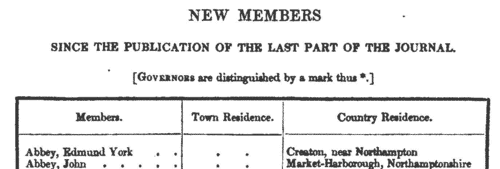Our indexes include entries for the spelling meredith. In the period you have requested, we have the following 1,060 records (displaying 591 to 600):
Petitioning Creditors and Solicitors
(1840)
Principal creditors petitioning to force a bankruptcy (but often close relatives of the bankrupt helping to protect his assets): and solicitors | Sample scan, click to enlarge

|
Trustees and Solicitors
(1840)
Trustees appointed to take over bankrupts' estates in England and Wales, and their solicitors. Trustees are often friends or relatives of the bankrupt: and/or principal creditors
| Sample scan, click to enlarge

|
Bankrupts' Assignees
(1841)
Assignees of bankrupts' estates (usually principal creditors and/or close relatives of the bankrupt) in England and Wales | Sample scan, click to enlarge

|
British Army officers
(1841)
The Royal Kalendar lists general and field officers of the British Army - five Field Marshals, 95 generals, 138 major-generals, 310 colonels, 637 lieutenant-colonels, 697 majors, in order of precedence according to year of precedence, and with the regiment indicated for each; then there are aides-de-camp to her Majesty queen Victoria; retired officers specially allowed to retain their ranks; and then the queen's land forces, set out regiment by regiment and battalion by battalion, naming the colonel, lieutenant-colonel and major for each, officers of the British garrisons, and of the Tower of London; and the officers of the Royal Regiment of Artillery (including the Field Train) and the Corps of Royal Engineers, by rank. | Sample scan, click to enlarge

|
British sea officers
(1841)
The Royal Kalendar lists the 177 flag officers of the Royal Navy; the 670 captains (including superannuated and retired) and 751 commanders. The captains and commanders are given in order of precedence, determined by the dates of their appointment. Then there is a list of the ships of the navy, annotated with the names of their captains, with a separate section for steam vessels; packet brigs at Falmouth; and mail steam vessels at Dover, Weymouth, Pembroke, Liverpool, Holyhead and Portpatrick. | Sample scan, click to enlarge

|
Dissolutions of Partnerships
(1841)
Trade partnerships dissolved, or the removal of one partner from a partnership of several traders, in England and Wales
| Sample scan, click to enlarge

|
Insolvents
(1841)
Insolvency notices for England and Wales: insolvency often caused people to restart their lives elsewhere, so these are an important source for lost links | Sample scan, click to enlarge

|
Insolvents
(1841)
Insolvency notices for England and Wales: insolvency often caused people to restart their lives elsewhere, so these are an important source for lost links | Sample scan, click to enlarge

|
Members of the Royal Agricultural Society of England
(1841)
The Royal Agricultural Society of England was founded in 1840 and rapidly attracted a wide membership of agriculturists. This list of members who joined between 1840 and 1841 was printed in the second volume of the society's journal. It gives each member's name in full (surname first), town residence (if any), and country residence.
| Sample scan, click to enlarge

|
Officers and officials of English hospitals
(1841)
The Royal Kalendar lists patrons, governors, officers and staff of the hospitals and infirmaries in and near London: Saint Bartholomew's; the Bridewell and Bethlem; St Thomas's; Emanuel; Asylum for Poor French Protestants; Westminster Hospital; Guy's; Bancroft's Hospital; St George's; the Foundling Hospital; the London Hospital; the Hospital for Casual Smallpox and Vaccination; Lock Hospital; Middlesex Hospital; the British Lying-in Hospital for Married Women; the City of London Lying-in Hospital; St Luke's Hospital for Lunatics; Queen Charlotte's Lying-in Hospital; the Asylum for French Orphans; the General Lying-in Hospital; the Jews Hospital; Seamen's Hospital Society; Magdalen Hospital; London Fever Hospital; Royal London Ophthalmic Hospital; Royal Sea Bathing Infirmary (at Westbrook near Margate); Royal Infirmary for Diseases of the Eye; Royal Westminster Ophthalmic Hospital; Infirmary for Asthma, Consumption and other Diseases of the Lungs; Charing Cross Hospital and Medical College; the Royal Metropolitan Hospital for Children; the Royal Maternity Charity for delivering Poor Married Women at their own Habitations; the General Dispensary for Relief of the Poor; Westminster General Dispensary; London Dispensary; Finsbury Dispensary; the Eastern Dispensary; the Public Dispensary; Marylebone General Dispensary; Queen Adelaide and British Ladies Lying-in Institution; the City Dispensary; the Western Dispensary; Surrey Dispensary; Tower Hamlets Dispensary; Bloomsbury Dispensary; the National Truss Society; the Rupture Society for the Supply of Trusses to the Indigent Poor; the City of London Truss Society; the National Vaccine Establishment; the Charitable Fund and Dispensary for Relieving the Sick Poor at their own Habitations with Medicines and Pecuniary Aid; the Northern Dispensary; the Royal Infirmary for Children; the Royal Dispensary for the Diseases of the Ear, and the Deaf and Dumb; the Royal Jennerian and London Vaccine Institution for the Extermination of Smallpox, for Gratuitous Vaccination, and Keeping up a Genuine Ichor; and St George's and St James's Dispensary. | Sample scan, click to enlarge

|
Research your ancestry, family history, genealogy and one-name study by direct access to original records and archives indexed by surname.











